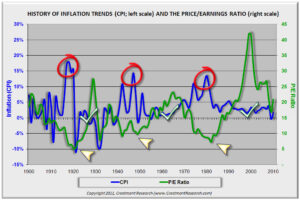To explain why higher inflation drives down P/E, let’s first think about the phenomenon of inflation itself. We talk about inflation whenever prices go up, but not all price increases are inflation. When the price of one thing or a few things goes up, that’s just a price increase. When the aggregate price of everything that you buy increases, that constitutes inflation. Inflation occurs when the federal government prints more money than the value of goods in the economy. The result is that the prices of things adjust upward to reflect the loss of money value.
That’s where interest rates come into the picture. Interest rates help to offset the loss of value due to excess money creation. That’s also why interest rates go up as inflation rises and fall as inflation declines. This is why bond prices and yields rise and fall as the expected inflation rate changes.
To illustrate, consider that bonds are financial securities that pay interest over time. A $100 bond with the interest rate of 5% pays $5 per year throughout its term. When market interest rates, as driven by inflation, are 5% then the bond is worth $100. But what happens when inflation rises and market interest rates go to 10%? Well the bond is not worth as much. Actually, the price of the bond declines so that the $5 interest payment and the $100 maturity value will yield 10% over the life of the bond. The key point is that rising inflation drives bond prices lower. Conversely, falling inflation makes those bond payments worth more since new bonds will pay lower interest payments. The result between bonds prices and inflation is a fundamental relationship driven by principles of finance.
Now let’s consider the stock market. Stocks are also financial assets. They often pay dividends from earnings quarterly or retain the earnings to build more value in the future. Either way, stocks are financial assets with a value today that is based upon future cash flows. And just as with bonds, when inflation rises, the value of stocks today falls to reflect higher market rates.
We measure the value of stocks using the ratio of market price to current earnings (the price/earnings ratio, or P/E). When inflation rises, stock prices fall–so the ratio of P/E falls too. This enables new buyers of stocks to pay a lower price in order to receive a higher return to compensate for inflation. Conversely, falling inflation drives stock prices and P/E higher.
When the inflation rate falls into deflation, there’s another financial principle that causes P/E to fall. But we’ll save that for another day.
Note the graph below. When blue line inflation is high (red circles), the green line P/E is below average (yellow arrows). Whenever inflation is low (green check marks), note that green line P/E is well above average. (There’s one good incidence of deflation and lower P/E in the 1930s, but we’re saving that for another day…) Inflation and P/E do bounce around a bit, yet the relationship follows the financial principles described above. Some people like the chart below (generally presented without the markings) and others prefer the one known as The Y Curve Effect. Both charts are available on the Crestmont Research website in the Stock Market section.

